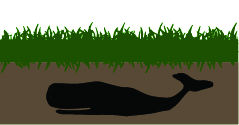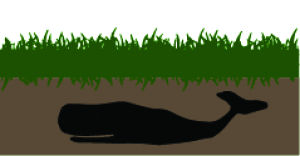Pygmy whale buried in Sweetheart Circle
October 28, 2013
On the short list of things buried in Georgia Southern University’s Sweetheart Circle, a whale is probably not mentioned.
That list, however, would be wrong.
Roughly two decades ago, Richard Petkewich, Ph.D., professor in the geology and geography department and paleontologist, worked at GSU. He was one of the earliest curators of the museum and helped develop the paleontological collection.
Petkewich specialized in marine mammals and had a license to collect beached specimens to bring back. He would de-flesh the carcasses to keep the bones for comparative study, which means that the bones would be compared to pre-historic paleontological collections, Brent Tharp, Ph.D., director of the GSU Museum, said.
When a beached pygmy sperm whale was discovered on one of Georgia’s coastal islands, Petkewich collected the whale and buried it on the sand hill across from Sweetheart Circle near the entrance of the university, Tharp said.
Pygmy sperm whales can grow between nine and a half and 11 and half feet and weigh between 600 pounds and 1,000 pounds, according to whalefacts.org.
The sandy hill was a good location because it was a high point, well drained, with sandy soil.
The idea was to leave the whale buried for a year or so in order to naturally de-flesh the bones, Petkewich would then go back and clean the remains off himself.
Petkewich became ill shortly after burying the whale and passed away.
“We’ve honestly lost the location, we don’t really know where. His notes didn’t give a precise enough location to know, really, other than it’s out there on the sand hill somewhere across from Sweetheart Circle there at the entrance,” Tharp said.
Finding the location of the whale has been attempted by consulting Petkewich’s son who helped him bury the whale. His son could not remember after so much time had passed, and the land has changed, Tharp said.
“We’ve discussed that at some point in time it might be an experiment to work with both the archaeology department and the geology department use for ground penetrating radar,” Tharp said.
Ground penetrating radar is a technology that gives the user an idea of where disturbed soil is located due to density changes that are detected by radar.
“[The technology] wouldn’t give us a shape that said ‘whale.’ All we would see would be the trench where the dirt was dug up but there is probably a lot of things running out there, utilities and other things,” Tharp said.
Petkewich’s notes are not on display in the museum, but they are in the museum collections. The notes do not give any indication as to the condition of the whalebones.
The pygmy sperm whale is not the only marine mammal that Petkewich buried, but it is the only one known to be buried under Sweetheart Circle.










